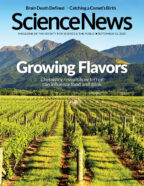Readers ask about positronium, wild bees and more
Dance of the doomed particles
Scientists are puzzled by an unexpectedly large gap in the energy levels of an exotic “atom” called positronium, which consists of an electron and a positron, Emily Conover reported in “Positronium result baffles physicists” (SN: 9/12/20, p. 14).
Reader Lee Skinner asked why the electron and its antimatter counterpart, the positron, don’t just annihilate each other when they collide.
Eventually, the electron and positron do annihilate one another, Conover says. As a result, positronium doesn’t stick around forever. “The two particles do a little orbital dance with each other for a period of time before they meet up and annihilate,” she says. “That’s actually part of how the researchers made the measurement, though I didn’t have the space to include those details in the story.” The team measured how long it took electrons and positrons to annihilate, which depends on the atoms’ energy level. “Timing that annihilation revealed whether the positronium atoms had jumped to a new energy level or not,” Conover says.
What’s the buzz?
Pollination by wild bees accounts for about $1.5 billion worth of yields for six U.S. crops, Susan Milius reported in “Wild bees are moneymakers for some U.S. farms” (SN: 9/12/20, p. 5).
Reader Steve Robinson wondered what species of wild bees the researchers observed.
Milius is glad that readers recognize there are many kinds of wild bees. “Common groups spotted in the survey included bumblebees, carpenter bees, Andrena mining bees and squash bees — named for some of their favorite flowers,” she says.
Hot and cold
A study of glass beads hints at how hot water can freeze faster than cold water, Emily Conover reported in “Hot beads chilled faster than cool ones” (SN: 9/12/20, p. 16).
“Makes you wonder about warming. Has anybody done the opposite experiment?” reader Robert Chester asked.
Conover hasn’t seen experimental evidence for cold water warming faster than hot water, but she says there is a theoretical study that suggests the effect is possible. For certain idealized materials, scientists have shown mathematically that atoms could heat up faster after a precooling phase. Scientists eventually may look for the effect in real materials such as magnetic alloys (SN Online: 2/13/20).
from Science News https://ift.tt/3loLmAQ


Comments
Post a Comment